Bard vs. ChatGPT: What's the difference?
ChatGPT took the spotlight for AI-generated content, and Google answered with Bard. While Bard and ChatGPT might perform similar tasks, there are differences between the two.
OpenAI's ChatGPT launched in November 2022, and it quickly became an internet sensation. Now, Google has introduced its own AI-powered chatbot in a battle between the tech giants.
Generative AI creates content after a user queries it, using data from its machine learning model. The content is generated automatically by AI to answer questions and create images, text or videos.
When OpenAI launched ChatGPT, people began looking for ways to use AI-generated content and AI technology for business, educational and personal purposes. However, AI experts warned that the information can mix up content when pulled from incorrect data sources. Generative content has its pros and cons.
Microsoft also plans to partner with OpenAI to increase AI capabilities.
Alphabet, Google's parent company, launched a conversational AI chatbot named Bard -- its answer to ChatGPT -- on March 21, 2023.
Even with similar functions, there are key differences between the two AI tools.
What is ChatGPT?
ChatGPT is an AI-powered chatbot that uses machine learning to answer queries in a conversational dialogue. OpenAI released ChatGPT on Nov. 30, 2022. Within five days, ChatGPT reached 1 million users, according to OpenAI CEO Sam Altman.
This article is part of
What is GenAI? Generative AI explained
GPT stands for Generative Pre-trained Transformer, which finds patterns within data sequences. ChatGPT currently uses the GPT-3.5 language model, which is trained from human-created text on the internet. The paid version, ChatGPT Plus, now uses the upgraded GPT-4 model. ChatGPT uses the AI language model to formulate responses to user queries.
Popular AI-generated content for ChatGPT includes the following:
- Written code.
- Product descriptions.
- Blog posts.
- Email drafts.
- Summaries of transcripts, meetings and podcasts.
- Simple explanations of complex topics.
- Law briefs.
- Translations.
- Jokes or memes.
- Social media posts.
What is Bard?
Google Bard is also an AI-powered chatbot that simulates human conversations with natural language processing and machine learning by drawing responses from the internet. Bard originally used Lamda for dialogue applications, but upgraded to Google's next-generation language model Palm 2 (Pathways Language Model). This model is better at commonsense reasoning, logic and mathematics compared with previous models, Google said in a blog. The company also said this model is faster than previous versions. Bard provides more detailed answers to questions asked than the typical Google search through this large language model.
Bard's main goal is to retrieve information in a simple answer versus a search engine results page. It provides information in a similar fashion to Alexa and Siri, but with links for users to gather more information.
Bard also works as a personal assistant and helps with tasks such as booking vacations, finding existing reservations and helping with meal planning. Bard uses more conversational or natural language queries for search rather than keywords used by search engines. Bard is available to the public and offers content in more than 40 languages and in more than 230 countries and territories.
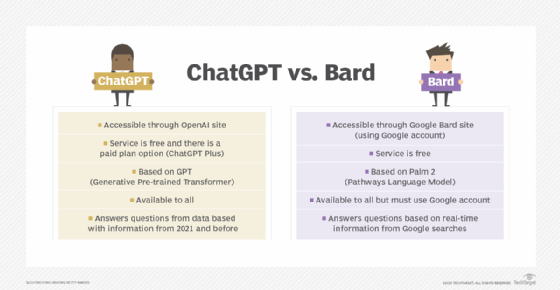
What are the main differences between ChatGPT and Bard?
The services of ChatGPT and Bard are similar, with users typing in a query to receive a humanlike response.
In February 2023, Microsoft announced it will release technology for large companies to create and customize their own chatbots using ChatGPT technology. Microsoft will also embed AI-powered search functions into its Bing search engine and Edge browser with a chat experience to aid a user's search. Google has not announced when it plans to add AI chatbot functionality to its search engine.
1. Data source
The main difference between ChatGPT and Bard is the data source. Bard continually draws information from the internet, so it has the latest information. ChatGPT's sources end with 2021 data, so it is limited on newer research and information. Bard has more data to gather information in real time by accessing the latest research.
Bard uses Google's newest language model, Palm 2. ChatGPT uses GPT-3.5, with GPT-4 technology available in its paid version, ChatGPT Plus.
2. User experience
Bard creates more chunks of information, while ChatGPT creates content in a single text prompt.
A user needs a Google account to sign on to Bard, while any email account works for ChatGPT.
3. Uses
Bard is made for research. ChatGPT is better for generating content, especially when data is given, such as summarizing an article.
Bard can use real-time data, so users can ask about current conditions such as the weather.
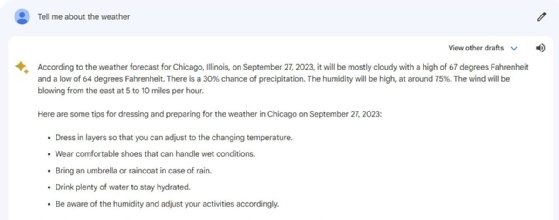
4. Data storage and privacy
ChatGPT stores all prompts and queries entered, no matter the topic or subject. Users can review previous conversations, which means the chatbot also reviews these conversations. Specific conversations can be deleted, but that information might already have been extracted to include in the large language model for the chatbot's training. This means that privacy could be an issue when entering personal data or proprietary information.
Google stores a user's Bard conversations in their Google account for up to 18 months, but users can change this to three or 36 months in their Bard Activity settings. Google Bard conversations can also appear in searches, so privacy could also be an issue.
Which chatbot is better?
ChatGPT is efficient at generating and summarizing text requests. Bard does a better job of answering questions with more relevant information. These chatbots are still being trained as users submit feedback, so there might be changes.
Pros of Bard:
- User-friendly interface.
- Better for research.
- Can research current information such as recent events.
- Can summarize webpages.
Cons of Bard:
- Does not track previous requests.
- Can be prone to AI hallucinations and make up information.
- Doesn't offer as many plugins and integrations.
- Sources aren't always reliable on the internet.
Pros of ChatGPT:
- Better at writing.
- Stores previous conversations.
- Can share responses with others.
- Offers various plugins and integrations with popular sites and apps such as Expedia, Instacart and Zapier.
Cons of ChatGPT:
- Need to copy and paste articles for summary.
- Responses can be long, making them difficult to scan.
- Must be fact-checked to prevent hallucinations or wrong information.
- The more advanced version is not free.
Comparison of the 2
To get an idea of the differences, here are ChatGPT's and Bard's different responses to the same requests and prompts.
Idea generation
Prompt: Give me five titles and ideas for trending technology articles.
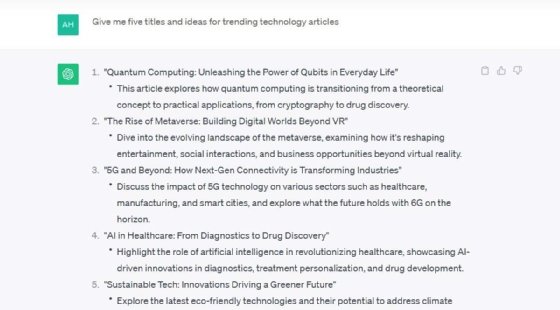
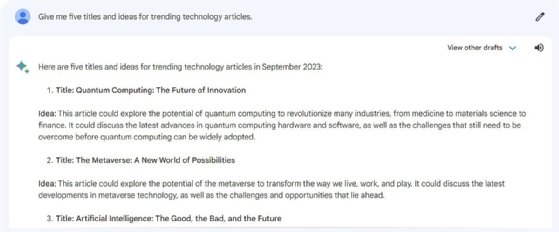

Thoughts: Bard gave a little more insight on article angles, while ChatGPT provided a few different topics. Because ChatGPT is limited to data through 2021, finding trending information can be difficult.
Creating content
Prompt: Create a two-paragraph summary explaining large language models.
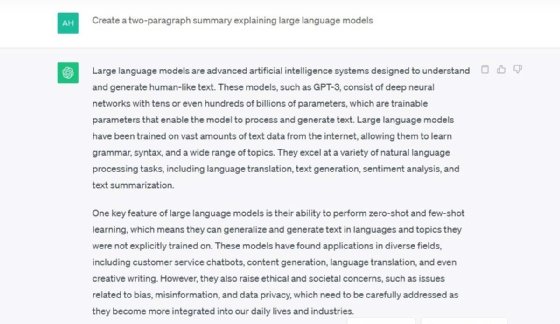
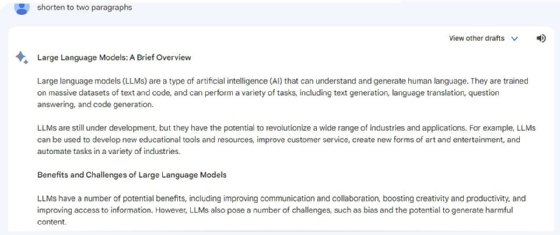
Thoughts: Bard needed an additional prompt to shorten to two paragraphs. ChatGPT's language was more comprehensive and easier to understand. Bard was more high level.
Research
Prompt: When was the first Barbie created?

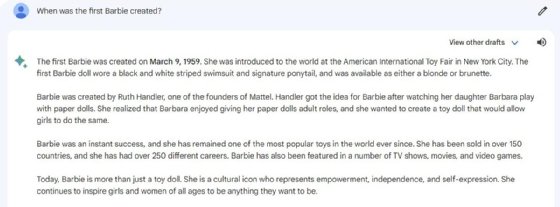
Thoughts: Bard's response was easier to read. The date was bolded to answer the question. ChatGPT had the same information, but text was chunky, requiring the user to look harder for the answer.
Planning
Prompt: Create an itinerary for a two-day trip to Chicago.
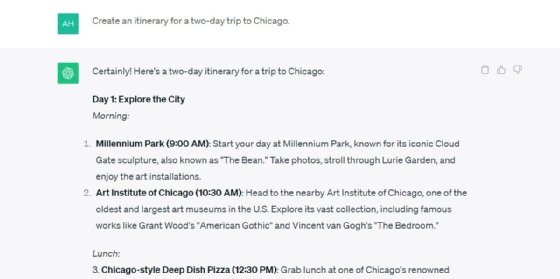
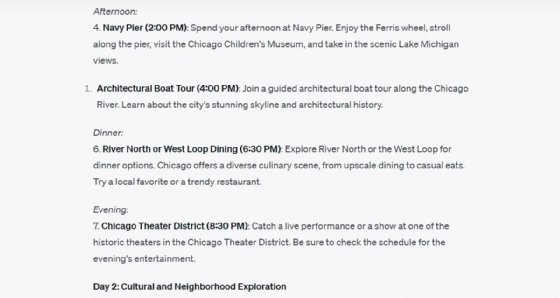
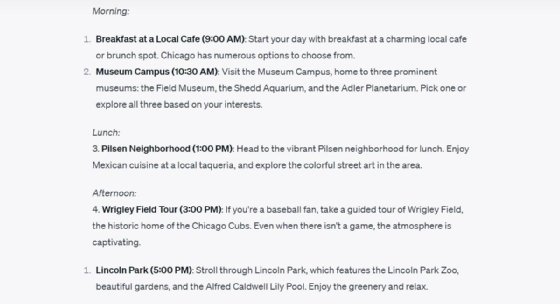
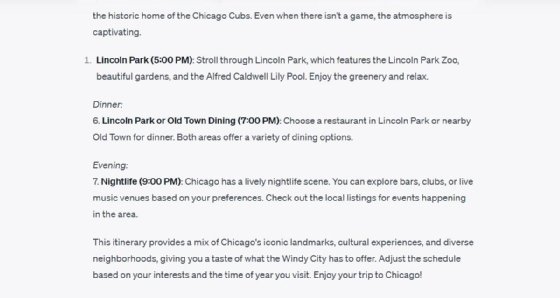


Thoughts: Bard provided useful information. However, ChatGPT was extremely detailed.
Generative AI alternatives
There are other AI content generators available. There are also several startups working on their own projects, including Chatsonic, Jasper, Open Assistant and Wordtune. China's largest search engine, Baidu, also uses AI with an application called Ernie Bot.
The future of AI in marketing continues to change and adapt as quickly as it started by finding additional uses beyond content generation, such as customer service, email optimization, product recommendations and social media posts.







